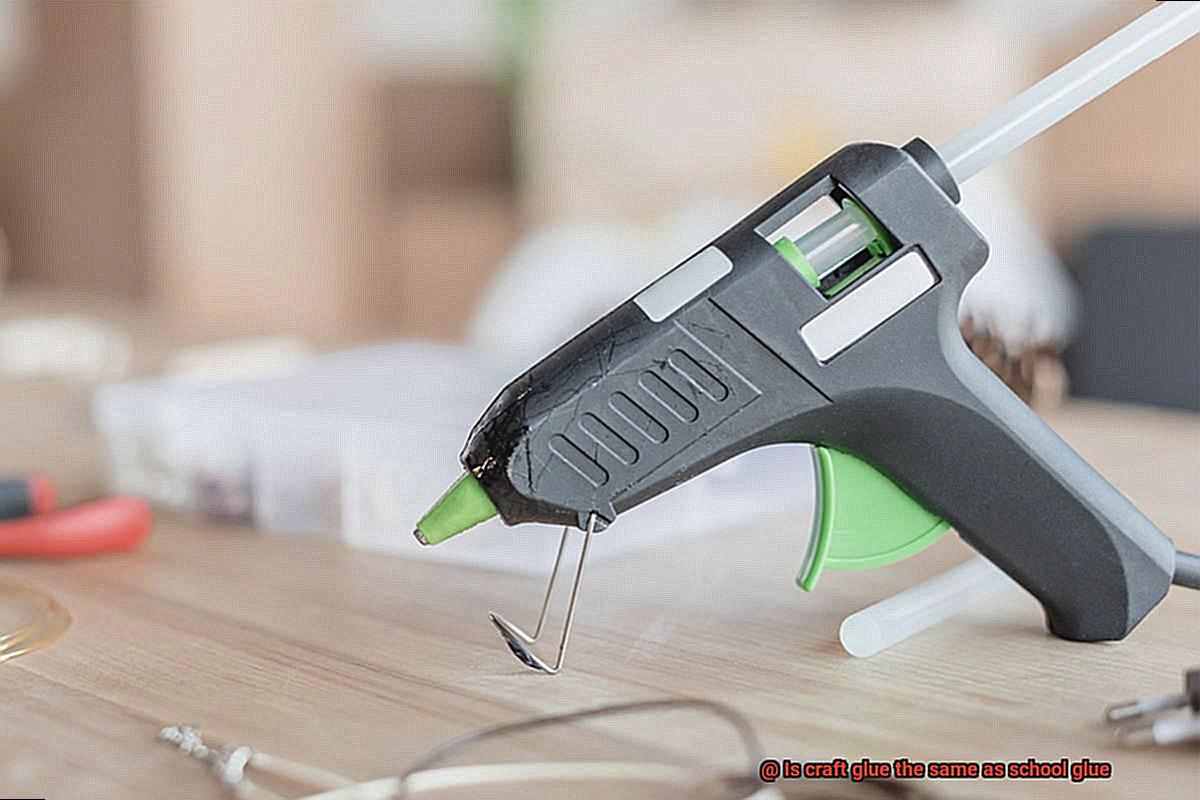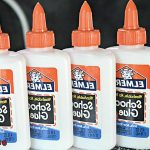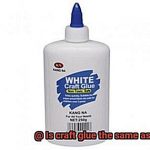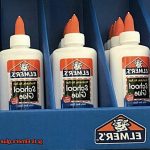Glue – that magical sticky stuff that holds our masterpieces together. But wait, are all glues created equal? Is craft glue just a fancy name for school glue? Buckle up, my crafty comrades, because we’re about to dive deep into the world of adhesives and uncover the truth behind these two popular players.
You might think that craft glue and school glue are like two peas in a pod, but let me tell you, they’re more like distant cousins with their own unique personalities. Sure, they both have some similarities – they’re water-based, easy to use, and won’t poison you if you accidentally lick them (not that I’m suggesting you should). But trust me when I say that their subtle differences can make or break your creative endeavors.
Choosing the right glue is an art form in itself. It’s like finding the perfect partner for your DIY projects – someone who understands your vision and sticks around through thick and thin.
So grab your goggles and put on your detective hat as we embark on this epic journey to unravel the secrets of craft glue versus school glue. By the end of this adventure, you’ll be armed with knowledge to make informed decisions and achieve flawless results in all your crafting escapades.
Ready? Let’s get sticky.
What is Craft Glue?
Contents
- 1 What is Craft Glue?
- 2 What is School Glue?
- 3 Similarities between Craft Glue and School Glue
- 4 Differences between Craft Glue and School Glue
- 5 Bond Strength of Craft Glue vs School Glue
- 6 Drying Time of Craft Glue vs School Glue
- 7 Ingredients Used in Craft Glue and School Glue
- 8 Choosing the Right Type of Adhesive for Your Project
- 9 Conclusion
Craft glue is an absolute must-have for anyone passionate about art and crafting. Whether you’re a seasoned crafter or just starting out, craft glue is an essential tool that should never be absent from your creative arsenal. Now, let’s dive deep into the captivating world of craft glue and uncover its purpose, uses, and incredible benefits.
Craft glue is specifically formulated to cater to the needs of crafting and art projects. Its unique composition allows it to bond quickly and securely to a wide variety of surfaces commonly used in crafts – surfaces like paper, cardboard, fabric, wood, and plastic. This means that craft glue can be utilized for an extensive range of creative endeavors, be it scrapbooking, card making, model building, or any other DIY craft that inspires you.
What makes craft glue truly remarkable is its versatility. It comes in different forms – liquid, gel, and stick – each tailored to cater to specific project requirements. Liquid craft glue is perfect for gluing larger areas or for those precise applications that require finesse, thanks to its fine tip. On the other hand, gel craft glue boasts a thicker consistency, making it the ideal choice for vertical surfaces or materials that demand a stronger hold. And if you’re looking for quick and mess-free bonding on paper or lightweight materials, craft glue sticks are the way to go.
One of the greatest advantages of craft glue is its water-based formula. This means that it’s easy to clean up and doesn’t emit unpleasant fumes or odors. Craft glue’s safety and non-toxic nature make it suitable for use in well-ventilated spaces and even in children’s crafting activities. However, as with any adhesive product, it’s always crucial to carefully read the manufacturer’s instructions and warnings before using any type of glue.
Craft glue also comes in various formulas designed to meet specific project requirements. Some craft glues are specially crafted for bonding fabric or foam, while others are formulated for use on delicate surfaces like paper or photographs. This wide range of options allows you to select the perfect craft glue to achieve optimal results for your specific project.
When searching for the right craft glue, it’s important to consider the needs of your project. If you’re working with lightweight materials such as paper or cardboard, a regular craft glue should be more than sufficient. However, if you’re dealing with heavier or three-dimensional objects, you might require a stronger adhesive with a higher bonding strength to ensure your creation stands the test of time.
What is School Glue?
School glue, also known as white glue or PVA glue (polyvinyl acetate for all you science buffs), is a remarkable adhesive that has become an essential tool in classrooms and art projects around the world. This water-based adhesive is not only safe and non-toxic but also incredibly versatile, making it the perfect glue for kids and students alike.
Let’s delve into the captivating world of school glue and uncover its sticky secrets.
First and foremost, school glue is a superhero when it comes to arts and crafts projects. Whether you’re creating collages, constructing paper sculptures, or fashioning a masterpiece with popsicle sticks, this glue is your trusty sidekick. It forms a powerful bond on paper, cardboard, fabric, and other porous materials, ensuring that your creations stay intact.
But school glue doesn’t stop there. It’s also a champion in the classroom for general purpose bonding. Need to stick up a poster? School glue has got your back. Want to secure some decorations on a bulletin board? You guessed it, school glue to the rescue.
This extraordinary adhesive has another trick up its sleeve – its appearance. School glue dries clear, leaving no unsightly residue behind on your beautiful creations. And let’s not forget about its drying time. Unlike other glues that set in an instant, school glue gives you a bit of wiggle room before it fully sets. So if you need to reposition something, no sweat.
And when it’s time to clean up the aftermath of your creative endeavors, school glue proves once again why it’s the ultimate companion. It’s washable. Just grab a damp cloth and wipe away any spills or excess glue with ease.
However, it’s important to note that school glue may not be suitable for all materials or applications. If you’re working with non-porous surfaces like glass or plastic, you might want to explore other adhesive options.
Similarities between Craft Glue and School Glue
The magical adhesive that holds our artistic endeavors together. But with a plethora of glue options available, how do you choose the right one? Today, we’ll explore the similarities between craft glue and school glue to help you make an informed decision.
Let’s start with the basics. Craft glue and school glue share similar ingredients, like water, adhesive polymers, and additives. This commonality allows them to effectively bond materials together. Whether you’re working on a school project or a creative masterpiece, both glues have got your back.
Another similarity is their non-toxic nature. This feature is crucial, especially in classrooms where children use them. You can rest easy knowing that these glues are safe for little hands and won’t cause harm if accidentally ingested.
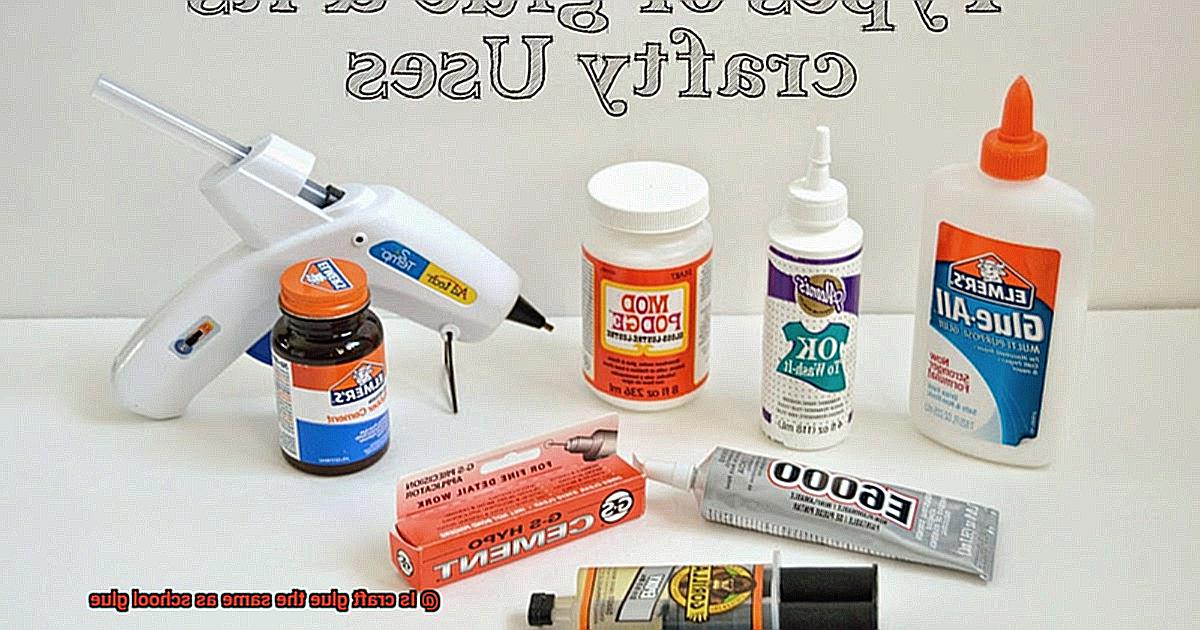
Ease of use is another common factor. Both glues have a simple application process – just squeeze or brush them onto your desired surface, and you’re good to go. Plus, they dry relatively quickly, so you don’t have to wait around forever to continue your project.
Versatility is a key feature of both glues. They can be used on various materials like paper, cardboard, fabric, and lightweight wood. So whether you’re working on a school assignment or creating a masterpiece at home, these glues have got you covered.
Accidents happen, especially when it comes to kids and crafting. But fear not. Both craft glue and school glue are washable. If you accidentally get some on your clothes or other surfaces, simply wash it off with water. No permanent stains or sticky messes here.
Accessibility is another similarity. You can find both glues in most art supply stores, stationery shops, and even general retail stores. They come in different sizes and packaging options to suit your needs, making them easily accessible for everyone.
Last but not least, we can’t forget about cost-effectiveness. Both glues are relatively affordable, making them budget-friendly options. Teachers, in particular, will appreciate this as they often need to purchase large quantities for their classrooms.
In conclusion, craft glue and school glue share many similarities in terms of composition, non-toxicity, ease of use, versatility, washability, accessibility, and cost-effectiveness. They are reliable and effective bonding solutions for a wide range of arts and crafts projects.
Differences between Craft Glue and School Glue
Craft glue and school glue may appear similar, but they differ in composition, strength, drying time, and intended use. Craft glue, made from strong adhesives like polyvinyl acetate (PVA) or epoxy, bonds materials like wood, fabric, metal, and plastic. Conversely, school glue contains weaker adhesive polyvinyl alcohol (PVA), making it safe for children and easy to wash off surfaces.
Craft glue’s robust bonding capabilities withstand heavy loads, ideal for long-lasting projects like woodworking or model making. In contrast, school glue suits lighter-duty tasks and may not withstand significant stress or weight.
Craft glue dries faster than school glue, allowing efficient project completion. School glue’s slower drying time benefits classrooms where children require ample time to position materials before it sets.
Specifically formulated for crafts and DIY projects demanding a strong bond, craft glue excels in jewelry making, scrapbooking, and woodworking. School glue primarily serves classroom use. Its weaker adhesive properties make it safer for children and easier to clean up.
Bond Strength of Craft Glue vs School Glue
When it comes to glue, not all adhesives are created equal. Craft glue and school glue, two popular choices for various projects, differ in terms of bond strength. Let’s delve into the world of glue and explore the factors that influence the bond strength of craft glue versus school glue.
Craft glue is a versatile adhesive designed for a wide range of craft projects. From paper crafts to fabric crafts and small DIY projects, craft glue is the go-to choice. Typically water-based and non-toxic, this glue is safe for children to use. Craft glue offers a strong bond suitable for lightweight materials like paper, cardboard, and certain fabrics. Its quick-drying properties ensure that your projects come together swiftly.
On the other hand, school glue is commonly found in educational settings. Also water-based and non-toxic, this adhesive is specifically formulated for bonding paper and similar lightweight materials. School glue is less viscous than craft glue, making it easier for young children to handle and apply. While it may not provide the same level of bond strength as other adhesives, school glue is adequate for most classroom activities and art projects.
Several factors influence the bond strength of these glues. The specific type or brand of glue plays a significant role. Different formulations can yield different results when it comes to bond strength. It’s crucial to read product labels and instructions to determine the suitability of a particular glue for your project.
Additionally, the intended application and materials being bonded are crucial factors to consider. Craft glue may not provide a strong enough bond for heavier or more durable materials like wood or metal. In these cases, it would be more appropriate to use a specialized adhesive designed specifically for these materials.
Drying Time of Craft Glue vs School Glue
The battle between craft glue and school glue is a familiar one for crafters and classroom project enthusiasts alike. The drying time of glue can make or break a project, determining whether you can move forward or have to wait in frustration. So, let’s dive into the world of these two types of glue and uncover the differences in their drying times.
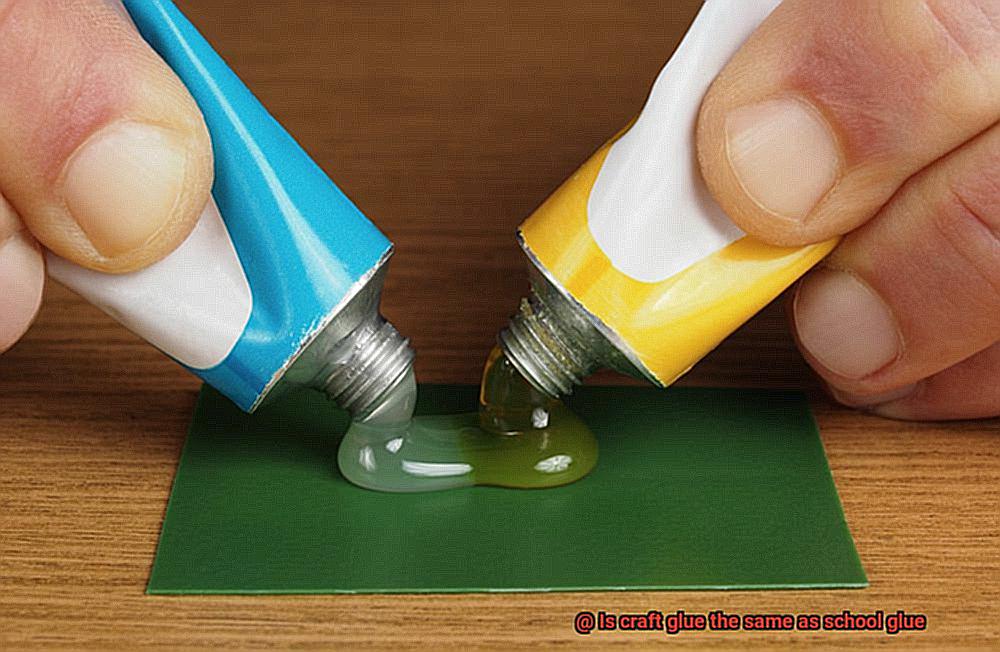
Craft glue, also known as craft adhesive or craft paste, is like the Flash of the glue world. It zooms through the drying process, allowing you to race ahead with your project. Craft glue contains special ingredients that speed up the drying time, making it the go-to choice for crafters who demand quick results. Whether you’re sticking paper, fabric, wood, or plastic, craft glue will have you covered with its fast-drying superpowers.
On the other hand, school glue is more like the reliable sidekick. It may not dry as fast as craft glue, but it still gets the job done. School glue, also known as white glue or PVA glue, is often used in educational settings and is safe for children to use. Its longer drying time provides more flexibility and forgiveness when mistakes happen. Plus, it’s water-based, so cleaning up any spills or mishaps is a breeze.
So how long does it actually take for these glues to dry? Well, craft glue can dry within minutes to hours, depending on factors such as environmental conditions and application thickness. On the other hand, school glue may take several hours or even overnight to fully dry. But don’t worry, young crafters and busy classrooms – there are quick-drying versions of school glue available that can speed up the process.
In conclusion, while craft glue may be the speedster of the adhesive world with its fast-drying abilities, school glue offers a reliable and forgiving option with its longer drying time. Whether you’re a craft enthusiast or a teacher leading a classroom project, understanding the differences between these two glues can help you choose the right one for your needs.
Ingredients Used in Craft Glue and School Glue
Craft glue and school glue are two adhesive options commonly used in various projects. Although they may seem similar, there are differences in the ingredients used in these glues that make them suitable for specific purposes.
Craft glue, also known as craft adhesive or craft paste, is formulated specifically for arts and crafts projects. It bonds a variety of materials like paper, cardboard, fabric, wood, and certain plastics. Craft glue typically contains synthetic polymers, with polyvinyl acetate (PVA) as the main ingredient in many craft glues.
PVA is a water-based adhesive that dries clear and flexible. Its strong bonding properties make it ideal for woodworking, bookbinding, and other crafts. PVA glue is non-toxic and safe for children to use. Some craft glues may also contain additives like preservatives to prevent mold growth or thickeners to enhance consistency.
In contrast, school glue, also known as white glue or washable glue, is primarily used in educational settings for art and craft projects. It is designed to be safe for children and easily washes off hands and clothing. School glue also contains PVA as its main ingredient, but its formulation may differ slightly. It often has a lower viscosity to make it easier for younger children to apply. Additionally, school glue may include coloring agents for visual appeal or fragrances to enhance the sensory experience.
Both craft glue and school glue are water-based adhesives that dry clear and are relatively easy to clean up. They are not intended for heavy-duty bonding or high-strength applications. Instead, they work best for lightweight crafts, paper projects, and temporary bonds.
Choosing the Right Type of Adhesive for Your Project
Selecting the appropriate adhesive for your project is a critical step in ensuring its success. The adhesive you choose will determine the strength and durability of the bond, as well as other factors like flexibility, cost, ease of use, and specific needs. To help you make an informed decision, here is a comprehensive guide to choosing the right type of adhesive for your project.
Strength is an essential consideration when it comes to adhesives. Different materials require different levels of bonding strength. For lightweight materials like paper or fabric, basic craft glue or school glue will suffice. However, if you’re working with heavier materials like wood or metal, opt for a stronger adhesive such as epoxy resin or wood glue.
Flexibility is crucial for projects that involve materials that need to bend or move. In such cases, choose adhesives that offer flexibility, such as fabric glue or certain types of epoxy resin.
Cost is another factor to consider. Adhesive prices can vary greatly depending on the brand and type. Consider your budget and the amount of adhesive you’ll need for your project. Investing in a higher-quality adhesive can often save you money in the long run by providing better results and lasting durability.
Ease of use is also important. Some adhesives come in convenient forms like glue sticks or adhesive dots/strips, which are easy to apply and control. Others may require more precision, such as liquid glues that need to be applied with a brush or nozzle. Choose an adhesive that suits your comfort level and the complexity of your project.
Specific needs should also be taken into account. Depending on your project, you may have unique requirements for your adhesive. For delicate materials or intricate work, a precision applicator or a clear-drying adhesive may be essential. If you need a quick bond, consider using super glue or hot glue, which provide instant results.
Other factors to consider include drying time, waterproof properties, and toxicity. Always read the instructions and specifications of each adhesive to ensure it meets your project requirements.
zumPCy2wuKg” >
Conclusion
Craft glue and school glue may appear similar at first glance, but they possess distinct characteristics that make them perfect for different purposes. Craft glue is tailor-made for art and crafting endeavors, boasting unrivaled versatility and formidable bonding capabilities. It effortlessly adheres to a wide array of materials and comes in various forms to cater to diverse project demands. Craft glue dries rapidly, ensuring efficient work in well-ventilated spaces or even by the hands of eager children.
On the flip side, school glue finds its niche primarily within educational settings, designed with the utmost safety in mind. Its leisurely drying time allows for greater flexibility when arranging materials, making it ideal for lightweight projects. Plus, it washes away with ease, leaving no trace behind.
While both glues share common traits such as being water-based, non-toxic, user-friendly, versatile, accessible, cost-effective, and washable – their composition, bond strength, drying time, and intended use set them apart. Craft glue reigns supreme with its robust bond and swift drying properties compared to its scholastic counterpart.
When selecting the perfect adhesive for your project, take into account factors like the materials involved in bonding, desired bond strength, drying time requirements, flexibility needs, cost considerations, ease of use preferences – not forgetting specific project constraints like toxicity or waterproofing – and even the age group of users if applicable.
By grasping the disparities between craft glue and school glue while considering these crucial factors during your adhesive selection process – you’ll ensure triumphant outcomes in all your creative exploits.

